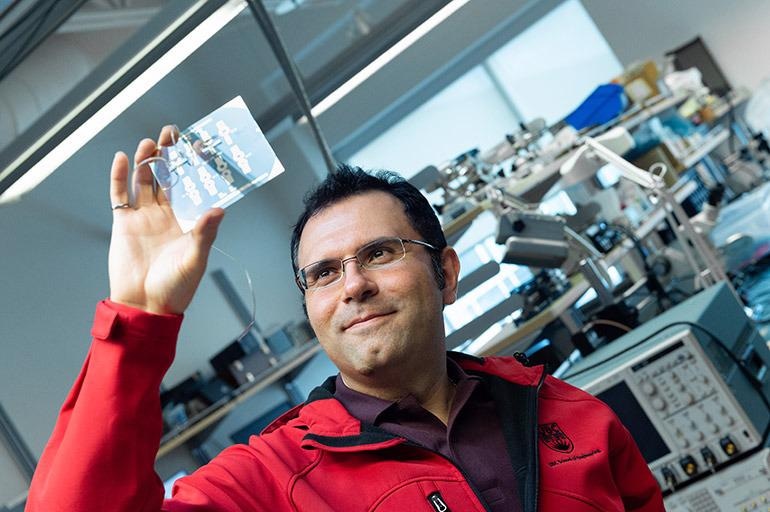Dec 18 2020
A new study by researchers from UBC Okanagan has transformed how aircraft and wind turbine operators deal with the risks associated with the build-up of ice.
 School of Engineering Mohammad Zarifi has made significant improvements to the real-time sensors that monitor frost and ice build-up on airplanes and turbines. Image Credit: UBC Okanagan.
School of Engineering Mohammad Zarifi has made significant improvements to the real-time sensors that monitor frost and ice build-up on airplanes and turbines. Image Credit: UBC Okanagan.
As part of a follow-up to a study published early this year, Assistant Professor Mohammad Zarifi and his colleagues at UBCO’s Okanagan MicroElectronics and Gigahertz Applications (OMEGA) Lab have extended the scope and functionality of their ice sensors.
We received a great deal of interest from the aviation and renewable energy industries stemming from our initial findings which pushed us to expand the boundaries of the sensor’s responsiveness and accuracy.
Mohammad Zarifi, Assistant Professor, OMEGA Lab, UBC Okanagan
The build-up of ice on wind turbines and aircraft can affect the safety and efficiency of their systems, added Zarifi.
In the latest study, the team focused on optimizing the real-time response of the sensors to detecting the build-up of ice and frost. The sensors can determine, in real time, such accumulations while also estimating the rate of melting. This data is vital for aviation (to ensure on-time flights) and renewable energy applications, noted Zarifi.
Power generation output of wind turbines diminishes as a result of ice accumulations. So, the industry sees great promise in sensing and de-icing solutions that can mitigate those reductions in efficiency.
Mohammad Zarifi, Assistant Professor, OMEGA Lab, UBC Okanagan
According to Zarifi, the patented sensor also includes a protective layer and is currently being tested by the aviation industry by implementing a stringent approval process. This is highly essential before the sensor can become a permanent feature on aircraft. He added that grants announced recently from the Department of National Defense will allow his team to continue to optimize the capabilities of the sensor.
Moreover, Zarifi has been partnering with several wind turbine companies to enable the sensors to be used in wind farms. According to him, the wind farm application is a somewhat more straightforward proposition since the sensors can be installed at the same altitude as the blades without the need to be fixed to the blades, thereby eliminating some calculation variables associated with motion.
In between these advancements, the team has unraveled another first relating to ice sensing technology. Their most recent innovation can sense salty ice, which tends to freeze at colder temperatures.
There has been more and more attention toward understanding and monitoring the formation of saltwater ice due to problems caused by saltwater ice on marine infrastructure and oil rigs. Zarifi and his colleagues at OMEGA Lab have been making efforts to introduce microwave/radar-based technology to overcome this difficulty.
The sensor can be integrated with an antenna to enable the results to be shared in real time with the operator to deal with the accumulation of ice.
Zarifi added that he and his colleagues are as excited as the industry collaborators to observe how their microwave and antenna, which have been established as robust and durable, can be tweaked for different applications, such as ice and moisture sensing.
The study was financially supported by a National Sciences and Engineering Research Council of Canada Discovery Grant, Mitacs Accelerate Grant, and grants from the Canada Foundation for Innovation, and the Canadian Department of National Defense.
Journal Reference:
Kozak, R., et al. (2020) Modified Microwave Sensor with a Patterned Ground Heater for Detection and Prevention of Ice Accumulation. ACS Applied Materials and Interfaces. doi.org/10.1021/acsami.0c17173.